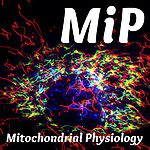Szibor 2013 Abstract MiP2013
| Szibor M, Heidler J, Gizatullina Z, Salwig I, Dhandapani PK, Wittig I, Rustin P (2013) Expression of Ciona intestinalis alternative oxidase in mouse. Mitochondr Physiol Network 18.08. |
Link:
MiP2013, Book of Abstracts Open Access
Szibor M, Heidler J, Gizatullina Z, Salwig I, Dhandapani PK, Wittig I, Rustin P (2013)
Event: MiPNet18.08_MiP2013
The primary objective of this study was to examine the consequences of expressing al-ternative mitochondrial respiratory enzymes under conditions of mitochondrial dysfunction in vivo. Multiple evidence indicates that Ciona intestinalis alternative oxidase (AOX) can safely be expressed in mammalian cells, where it is efficiently targeted to mitochondria and enzymatically active under conditions where the final enzyme of the electron transfer-pathway, cytochrome c oxidase (COX), is inhibited either chemically and/or genetically [1-3].
AOX was targeted to the ROSA26 locus where it is expressed under the control of the strong and ubiquitous CAG promoter. We analyzed the general expression pattern by Western blots, consequences of AOX expression on complex assembly by two-dimensional blue native/SDS-PAGE and respiration of isolated mitochondria.
ROSA26AOX mice are viable and have no obvious phenotype or alteration in physiological parameters. AOX is expressed in most tissues with highest level in heart, skeletal muscle, lung and liver while expression in the brain is virtually absent. Where expressed, AOX exists as a monomer but also forms higher assemblies. The majority of AOX is freely diffusible and not integrated into supercomplexes. Functionally, AOX expression supports azide- and antimycin A-resistant respiration. However, the degree of mitochondrial coupling in AOX-supported respiration depends on the applied substrates and inhibitors of the respiratory complexes.
Therefore, AOX expressing mice represent a valuable and versatile tool to study mito-chondrial dysfunction in vivo. The ROSA26AOX mouse will help to rescue disease models of mitochondrial dysfunction thereby deciphering molecular mechanisms and aiding in the eventual development of therapies. In addition, exploiting alternative respiratory enzymes is a novel approach to studying mitochondrial respiration and its control mechanisms.
• O2k-Network Lab: DE Magdeburg Gellerich FN, DE Frankfurt Droese S, FI Helsinki Jacobs HT
Labels: MiParea: Respiration, Genetic knockout;overexpression, mt-Medicine
Organism: Mouse
Tissue;cell: Heart, Skeletal muscle, Nervous system, Liver, Lung;gill
Preparation: Isolated mitochondria, Oxidase;biochemical oxidation
Enzyme: Complex IV;cytochrome c oxidase
Regulation: Coupling efficiency;uncoupling
Coupling state: LEAK, OXPHOS
Pathway: ROX
HRR: Oxygraph-2k
MiP2013
Affiliations and author contributions
1 - Research Program of Molecular Neurology, University of Helsinki, Finland;
2- Dept I - Cardiac Development and Remodeling, Max Planck Institute for Heart and Lung Research, Bad Nauheim, Germany;
3 - Dept of Molecular Hematology, Goethe University, Frankfurt, Germany;
4 - University Dept of Neurology, Otto-von-Guericke University, Magdeburg, Germany;
5 - Functional Proteomics, SFB 815 core unit, Faculty of Medicine, Goethe University, Frankfurt, Germany;
6 - Inserm, UMR 676, Hôpital Robert Debré, Paris, France;
7 - Faculté de Médecine Denis Diderot, Université Paris, France;
8 - Institute of Biomedical Technology, University of Tampere, Finland.
Email: marten.szibor@helsinki.fi
References
- Dassa EP, Dufour E, Goncalves S, Jacobs HT, and Rustin P (2009) The alternative oxidase, a tool for compensating cytochrome c oxidase deficiency in human cells. Physiol Plant 137: 427–434.
- El-Khoury R, Dufour E, Rak M, Ramanantsoa N, Grandchamp N, Csaba Z, Duvillié B, Bénit P, Gressens P, Sarkis C, Jacobs HT, Rustin P (2013) Alternative oxidase expression in the mouse enables bypassing cytochrome c oxidase blockade and limits mitochondrial ROS overproduction. PLoS Genet 9: e1003182.
- Hakkaart GAJ, Dassa EP, Jacobs HT, Rustin P (2006) Allotopic expression of a mitochondrial alternative oxidase confers cyanide resistance to human cell respiration. EMBO Rep 7: 341–345.
